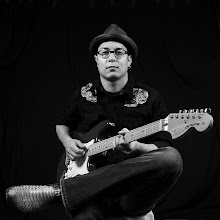I started another project for my drummer Jason's nephew, Nolan. Apparently his birthday is coming up and and this 16 yr old needs a respectable guitar to play on instead of the POS Dean he has...
I thought I'd document as much as I could. I kept forgetting to take pictures but I think I got most of it through the process.
First thing is to get a board from the lumber store. Usually they are trimmed up for the most part. The board I chose was 8/4 Ash. 8/4 means there are eight 1/4", meaning 2", but usually that translates to 1.75". A standard Fender body is 1.75" thick so we are good to go. G2G! I need 13" at the widest bout so its either find a 13" wide piece (difficult to find) or glue up two boards to make the 13" (easier to do). I select an 8" wide board that is 10ft long, which will allow me to make 3 complete bodies. My typical searching sizes is 7+" x 40" for one center joined guitar blank, although have used as short as 7"x 36". Knowing these sizes I have the lumber store chop them into three identically lengthened pieces.
I know I only need two 7"x16" pieces, but I measure out 20" as that is the typical length for a Stratocaster style body. Since this is already mostly sanded on the faces, I can skip the thickness sanding portion of the build. So next step would be using the miter saw (aka the chop saw) to chop the correct lengths for both halves. The chop saw has a 1/8" wide blade, so you have to factor that material disappearing in your lengths. No big deal here since I have an extra ~4". Usually before I do the actual cutting I trace half the template on the raw wood to see what grain shapes will be in the body. Below you can see that the center sections will have mostly straight grains, and towards the edges there's a little flair akin to what you'd see around a knot, or a growth ring.
After the reference holes are drilled, I go back to the band saw and cut the wood so that there is maybe a 1/32" excess around my drawing. I have a few spare templates due to mess ups that I use as a visual reference since the bandsaw tends to shake the body to where its a little difficult to be precise on where to cut.
When you are done with the bandsaw a second time, you'll have something close to a shape...like this...
At this point you can take it to your router to cut off the excess wood, but I go one more step before I take it to the router. The router is a finesse tool. Its not a blunting tool.You literally just want to take off very very little amounts with the router, otherwise you'll get wood burn, or you'll make the bit grab the wood and rip--the latter being the less desirable outcome. Because of the ripping situations I've experienced in the past, I take the body to the drill press where I have a mock drum/spindle sander set up. I bought this sander from Stewart MacDonald and its slightly better than other drum sanders you can get as it has a circular plate on the bottom that mimics the role of a bearing on a router bit. My dad created a jig so that I'm not putting horizontal pressure on the drill press chuck. An oscilating sander would be a better choice, but I currently don't have one, so this will have to do.
Here's another photo that describes the direction to cut.
Here's pics of the pickup channels and the control channel cut. The control channel has a 1/4" bottom (ie. 1.5" are cut away), so usually I'll cut 1" depth with my 1" long bit, then remove the template and run the bearing on the previously cut area to get the final depth.
And the end result
Once this is done I have cut the neck pocket and round the body over.
On that note...this guitar body is done, and is off to the finishing stage. This guitar is going to get a transparent black stain, sealed, filled, and then a thin gloss coat of Nitrocellulous lacquer. More on that in the next blog. In the meantime here's a teaser of the body...
